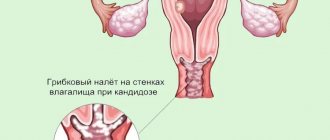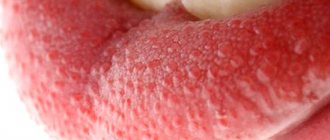1.General information
In order not to be interrupted by terminological references in the future, we will stipulate the following as a kind of preamble.
Opportunistic is an infection that occurs, literally, “at an opportunity,” “if possible,” i.e. under a certain combination of conditions favorable for the opportunistic microorganism. In turn, conditional pathogenicity implies asymptomatic parasitism or commensalism (harmless coexistence) of any microculture in the host’s body - as long as the host is healthy and immunocompetent - and the ability of this culture to undergo rapid pathogenic activation with a weakening of the immune defense, a significant change in the structure of the microbiome and some other circumstances.
Mycosis is a systemic infection by fungal cultures. Candidiasis is an extremely widespread (in fact, the most common) variant of mycosis, caused by yeast-like opportunistic fungi of the numerous genus Candida, most often Candida ablicans (the causative agent, in particular, of urogenital “thrush”).
Thus, pharyngeal candidiasis is an opportunistic mycosis caused by the activation of Candida and predominantly localized in one of the ENT organs.
A must read! Help with treatment and hospitalization!
Candidiasis of the pharynx
Pharyngeal candidiasis is a fungal disease caused by Candida fungi. The cause may be irrational use of antibiotics, weakened immunity after acute infections. Symptoms and course:
Mild general malaise, low-grade fever, slight inflammation of the tonsils - redness, whitish deposits.
Recognition:
Based on the detection of fungus by microscopy of plaque.
Treatment
Antifungal antibiotics (nystatin, levorin, etc.), for lubricating the tonsils - iodine preparations (iodinol, Lugol's solution for a long time). Without timely treatment, the disease becomes chronic.
For throat candidiasis, treatment is carried out either with systemic drugs or with general drugs. How to treat throat candidiasis in each specific case is decided by the doctor based on the examination and tests taken by the patient. In the initial form of acute disease, local drugs can be quite effective. At the same time, in the event of a relapse of a chronic disease, when the fungus has spread throughout the body, there is no point in using local drugs against the Candida fungus in the throat; treatment in this case should be systemic and aimed at improving the health of the whole organism.
Treatment should include, first of all, the abolition of all antibiotics already used. Sulfadimezin can be used internally, as well as local agents useful in the treatment of fungal diseases. Thus, it is advisable, as was previously practiced in the treatment of thrush, to lubricate with a 10% solution of borax in glycerin. Lubricants with pyoxanthin, 2% gentian violet solution, 1% brilliant green solution and 3% methylene blue solution are used. Lubricating with a solution of iodine with potassium iodide in glycerin (Lugol's solution) is effective. It is recommended to repeatedly lubricate the lesions with a 0.1-0.25% aqueous solution of copper sulfate. Iodine therapy is also prescribed (up to 3-5 g of sodium or potassium iodide orally for several days before the first signs of iodism). Vitamins C and B vitamins are prescribed: riboflavin 0.01-0.02, vitamin B1 0.04, nicotinic acid 0.05-0.1 (3 times a day after meals).
The most effective for candidiasis, especially in weakened patients who need continued drug treatment, is the special antifungal antibiotic nystatin (synonyms - mycostatin, fungicine). For adults, nystatin is prescribed in courses of 5-10 days orally (500,000 units 5 times a day in the form of tablets, i.e., only 50-100 tablets per course). The effect is observed from the second day of administration.
2. Reasons
In the clinic of infectious diseases, the main and universal cause, as well as a risk factor, is weakened immunity - no matter what causes the decrease in the body’s natural defenses. However, since the mid-twentieth century, another factor has appeared (and continues to gain strength), which is extremely “convenient” and favorable specifically for fungi. We are talking about antibiotics, which are often used as self-medication, in irrational doses, for too long a course, or in situations where antibacterial drugs are objectively not needed at all.
Suppression or destruction of bacterial microflora, including those that perform protective functions as a symbiont (it should be noted here that broad-spectrum antibiotics are not named this way by chance), disrupts the optimal balance in the microecological system of the human body, and fungi begin to occupy the vacated niche. According to modern estimates, fungal infections of the oral cavity and pharynx account for 40% of all mycoses of the mucous membranes. In the total volume of recorded oropharyngeal fungal invasion, candidiasis accounts for 90-95%. The remaining cases are caused by aspergillus, penicillium and other fungi, as well as their combinations (mixed pharyngomycosis).
The importance of risk factors such as diabetes mellitus, AIDS (every tenth patient with acquired immunodeficiency syndrome dies from fungal infections), smoking, allergic hypersensitivity, long-term use of hormone-containing anti-inflammatory drugs, oral sex with a carrier of genital candidiasis, as well as intestinal dysbiosis has been reported.
Visit our Otolaryngology (ENT) page
Causes
Candidiasis (thrush) affects not only external but also internal organs. The cause of the disease is yeast-like fungi that live in the body of every person.
- Many factors can provoke intensive reproduction of the fungus. For example, hypothermia, illness, stress, changes in hormonal levels (during pregnancy or taking hormonal medications).
- When taking antibiotics, along with pathogenic bacteria, the beneficial microflora of the intestine and vagina, which controls the growth and development of Candida fungi, also dies. The presence of a chronic disease that reduces the activity of the immune system (HIV, sexually transmitted diseases, infections) very often causes candidiasis.
- Candidiasis may be accompanied by endocrine diseases (diabetes, obesity, thyroid dysfunction).
- Finally, candidiasis can be caused by a hot climate or wearing uncomfortable tight or synthetic underwear.
The source of infection with candidiasis, as a rule, is the body’s own flora (autoinfection), but infection can occur from the outside. When causing a disease, the fungus does not change its properties - the body changes its properties (local protection decreases). Attaching to epithelial cells, the pathogenic fungus begins to parasitize them, penetrating deep into the tissues.
In the body's fight against candidiasis, a dynamic balance often arises when the fungus tries to penetrate deeper into the tissue, but cannot, and the body tries to reject it and also cannot. In this case, the process can last for years; a shift in balance in one direction or another will lead either to recovery or to an aggravation of the process.
Candidiasis occurs in several forms depending on certain characteristics.
- Carriage. A person is a carrier of the disease. There are no symptoms of candidiasis and there is no need to treat.
- Acute. Accompanied by itching, rashes, and discharge. Treatment must be comprehensive and high quality. Young children are most often susceptible to infection.
- Chronic. Symptoms subside and manifest; relapses are possible. It develops if it is not treated correctly with antibiotics for a long time, or if hormonal contraceptives are used.
This disease has several varieties, since it does not have an exact localization in the body:
- Urogenital candidiasis in women.
- male.
- Thrush of the lips
- On skin folds (armpits, area between the buttocks, inguinal folds).
- Gastrointestinal tract (stomach, esophagus, intestines, anus).
3. Symptoms and diagnosis
As a rule, pharyngeal candidiasis occurs with few symptoms or with moderate severity of clinical manifestations. Typical symptoms include inflammation of the tonsils and mucous membranes, a dirty white coating, low-grade fever, mild malaise, discomfort or pain when swallowing.
Granulomatous, atrophic, hyperplastic, erosive-ulcerative forms are relatively less common, requiring differential diagnosis, in particular, with tuberculosis.
Candidiasis of the pharynx is easily chronic and occurs, as a rule, in waves.
The prognosis worsens when the mycotic infection spreads to adjacent and internal organs.
If oropharyngeal candidiasis is suspected, a smear is taken from the affected surface, then a culture is performed on a nutrient medium; Recently, genetic identification (PCR) and serological tests (detection of specific antibodies) have been increasingly used.
About our clinic Chistye Prudy metro station Medintercom page!
Symptoms
Infection of the oral mucosa by Candida fungus can take various forms, each of which has its own characteristics of symptoms. The most common forms of the disease are candidal angulitis, glossitis, cheilitis, and stomatitis. There are both acute and chronic forms of the disease.
- Pseudomembranous acute candidiasis is the most common form and most often occurs in infants and the elderly. This form is characterized by the appearance of severe swelling and hyperemia (redness) of the mucous membranes. In addition, a characteristic whitish coating forms on the surface of the lips, palate, back of the tongue and the inside of the cheeks. If the plaque is scraped off, the surface of the mucous membrane underneath will be macerated (softened) or ulcerated and bleeding. In this case, patients complain of pain, burning or itching in the mouth; Eating becomes very difficult. Very often the process spreads to the esophagus and pharynx.
- Acute atrophic candidiasis of the oral mucosa usually develops due to the lack of adequate treatment. The upper part of the mucous membranes (epithelium) is exfoliated, the mucous membrane becomes thin, red or, on the contrary, swollen. The patient’s tongue and the corners of the lips also acquire a bright red color; the papillae on the tongue atrophy and smooth out. The plaque is absent or is found only in hard-to-reach places.
- Hyperplastic chronic candidiasis is characterized by the formation of a large number of papules and plaques of irregular or round shape. They are located close to each other on the mucous membrane of the tongue and cheeks and often become soldered and fused. Around each such formation there is a thin rim of reddened, inflamed tissue. It is difficult to scrape off or otherwise remove such a plaque. The oral cavity becomes dry and rough; When chewing, speaking, and even at rest, patients experience significant discomfort and pain. It should be noted that this disease most often affects men over 30 years of age.
The main cause of the chronic atrophic type is constant injury to the mucous membranes, for example due to wearing a prosthesis. Symptoms of the disease are localized in the affected area. Redness of the mucous membrane occurs (often along the contour of the lesion), plaque forms, pain and burning occur, and the membranes become dry.









